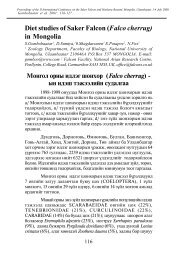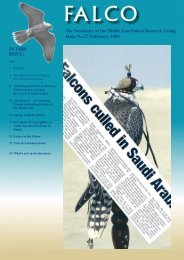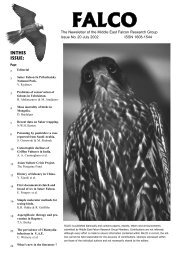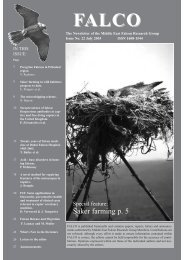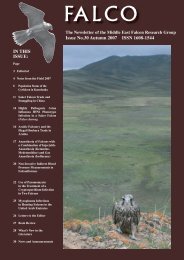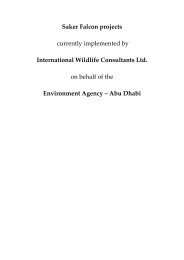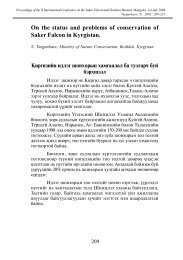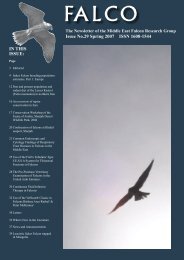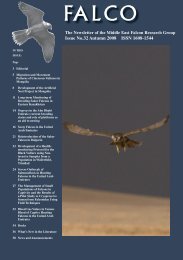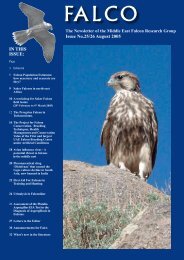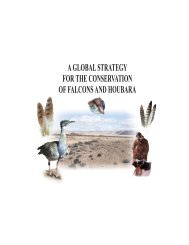Falco 28 - International Wildlife Consultants Ltd.
Falco 28 - International Wildlife Consultants Ltd.
Falco 28 - International Wildlife Consultants Ltd.
You also want an ePaper? Increase the reach of your titles
YUMPU automatically turns print PDFs into web optimized ePapers that Google loves.
clinically normal adults. However, significant<br />
differences were detected only between the RR. The<br />
different values obtained among the adult and juvenile<br />
population together with these findings support the<br />
effect of age on the RR and RE of clinically normal<br />
falcons.<br />
Similar results to the adult population were obtained<br />
when age criterion was ignored and falcons were<br />
classified according to training stage and health status.<br />
When only health status was considered and training<br />
stage and age were ignored, the results followed the<br />
same pattern. This was assumed to be due to the higher<br />
proportion of adult falcons in the study (257 falcons<br />
out of 400, almost two thirds of the total population).<br />
Conclusions<br />
The study demonstrates that the ET could provide an<br />
indication of respiratory disease in adult falcons, but this<br />
test has to be interpreted cautiously in juvenile birds.<br />
The lack of significance among the juvenile falcons is<br />
thought be due to several factors not analysed in this<br />
paper, such as nervous behavior, nutritional condition,<br />
weight in relation to size and breed. The effect of these<br />
factors on the ET need further study.<br />
Due to the above and other significant differences found<br />
in the analysis, age is shown to be the most relevant<br />
parameter at the time of performing the ET. Training<br />
stage was also proved to be important both for RR and<br />
RE mainly in adult falcons.<br />
Acknowledgements<br />
The authors thank His Highness Sheikh Hamdan bin Rashid<br />
al Maktoum for his continued support of the Dubai <strong>Falco</strong>n<br />
Hospital. We wish to thank Mr Humaid Obaid al Muhari, Dr<br />
Antonio Di Somma, the staff of the Dubai <strong>Falco</strong>n Hospital<br />
and the staff of the Fahad bin Sultan <strong>Falco</strong>n Center for their<br />
technical support.<br />
References<br />
Anon, (2003) Abu Dhabi <strong>Falco</strong>n Hospital, Comprehensive<br />
Care. Aspergillosis Client Information Sheet. Abu Dhabi.<br />
Environmental Research and <strong>Wildlife</strong> Development<br />
Agency.<br />
Lierz, M. (2000) Veterinary aspects of a falcon release<br />
project. The Veterinary Record 147: 518 – 520<br />
Samour, J. (2000) Clinical examination. Physiological data<br />
collection. In Samour, J. (ed) Avian Medicine. London.<br />
Mosby. pp 15 - 27<br />
Table 1: Number of falcons (N) and values (median a and 95% confidence interval for the median b ) of respiration rate before (RR)<br />
and after (RE) the endurance test examination.<br />
Age<br />
Training<br />
stage<br />
Clinically<br />
normal<br />
Respiratory<br />
Tract infection 1<br />
Other<br />
Diseases 2<br />
N RR RE N RR RE N RR RE<br />
Juveniles<br />
Trained<br />
22<br />
24.00 a<br />
(20.00-25.19) b<br />
36.00<br />
(24.00 -38.00)<br />
22<br />
24.00<br />
(24.00 – <strong>28</strong>.00)<br />
32.00<br />
(<strong>28</strong>.00 – 45.95)<br />
18<br />
24.00<br />
(20.00 -<strong>28</strong>.00)<br />
32.00<br />
(<strong>28</strong>.00 –35.09)<br />
Untrained<br />
20<br />
20.00<br />
(18.85 – <strong>28</strong>.00)<br />
<strong>28</strong>.00<br />
(24.00 – 47.67)<br />
51<br />
24.00<br />
(24.00 – <strong>28</strong>.00)<br />
48.00<br />
(38.01 – 75.00)<br />
10<br />
24.00<br />
(19.21 -42.48)<br />
36.00<br />
(23.61–121.98)<br />
Adults<br />
Trained<br />
58<br />
23.00<br />
(22.00 – 24.00)<br />
32.50<br />
(30.00 – 36.00)<br />
32<br />
<strong>28</strong>.00<br />
(26.00 – 29.96)<br />
46.00<br />
(41.00 – 59.91)<br />
34<br />
26.00<br />
(24.00 – 30.00)<br />
42.00<br />
(36.70 – 48.00)<br />
Untrained<br />
50<br />
26.00<br />
(24.00 – 27.00)<br />
36.00<br />
(33.07 – 42.00)<br />
47<br />
<strong>28</strong>.00<br />
(26.93 – 32.22)<br />
53.00<br />
(44.78 – 72.00)<br />
36<br />
26.00<br />
(23-00 – <strong>28</strong>.00)<br />
43.50<br />
(37.00 – 60.00)<br />
1<br />
<strong>Falco</strong>ns suffering from respiratory tract infections (148 falcons) were classified as follows: Acute (27) and regressed (21)<br />
aspergillosis, bacterial airsaculitis (37), mixed fungal and bacterial airsaculitis (4) and Serratospiculiasis (59). 2 <strong>Falco</strong>ns suffering<br />
from other diseases (102 falcons) were classified as follows: amyloidosis (2), crop trichomoniasis (12), candidiasis (5), intestinal<br />
coccidiosis (30) and other parasitosis (cestoda, nematoda and trematoda) affecting the gastrointestinal tract (23), lead toxicosis<br />
(6), viscerotropic Newcastle disease (5), bumblefoot (1), foreign bodies and gastrointestinal tract impaction (7), hepatitis (4),<br />
splenitis (3), septicemia (3) and other symptomatic undiagnosed diseases (11). Several falcons presented with more than one<br />
condition at the same time.<br />
18



